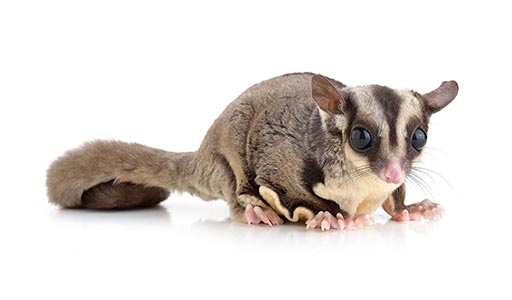Flying Squirrel Removal
Do you need to get rid of flying squirrels? We can help!

Flying Squirrel Removal Strategies
Flying squirrels are known for their ability to glide from one tree to another with the help of a wing-like structure on their body. Despite being able to fly, these creatures are very similar to regular squirrels. However, flying squirrels tend to be nocturnal beings who subsist off of primaryily fruit, insects, and seeds. Flying squirrels build nests in trees to hold their young.
Each one of our licensed specialists cares deeply for the well-being of all animals, large or small. Our humane removal techniques ensure that no animals are harmed as they are removed from your property. If you are worried about preventing these creatures from entering into your home or garage, a specialist at Trutech can evaluate your property and determine the proper flying squirrel control services that you need to prevent these creatures from causing even more damage. The time to find a solution for a flying squirrel invasion on your property is not when these flying creatures have invaded your personal space. Call the experts at Trutech to handle your problem efficiently, humanely, and with top quality customer service.
Flying Squirrel Problem

Signs a Flying Squirrel is on Your Property
If you come across a flying squirrel in your home or in your attic, do not try to trap it yourself. Flying squirrels can carry diseases and other illnesses in their fur and can spread these to humans if they come into direct contact. When you notice a problem with flying squirrels, call the experts at Trutech to come and help with proper flying squirrel removal.

Dangers of Flying Squirrel Infestation
Colonies of flying squirrels are made up of an average of a dozen rodents. Having so many flying squirrels inside man made structures like attics quickly leads to major property damage. They defecate and urinate near their nests, which creates foul odors in the home and damages buildings. As is the case with most rodent species, flying squirrels chew and gnaw constantly, which damages wooden support structures and electrical wires. Flying squirrels are also carriers of ticks, mites, fleas, and diseases, which are all easily transferred to residents living in infested homes.
Humane Flying Squirrel Removal & Control Strategies

Entry into property
Flying squirrels are common in yards across the United States, but property owners are often clueless to their presence. Since the rodents are nocturnal and tend to stick to the trees, people rarely encounter them. Human and flying squirrel activity intersects when the furry nuisances construct their nests in attics.

Trapping & Removal
Flying squirrels are legally protected animals in some states. In order to safely and effectively deal with flying squirrel infestations, property owners should call Trutech animal control specialists. Armed with the knowledge necessary to identify and address the factors causing flying squirrel activity, animal removal experts humanely and efficiently handle pest problems.

Prevention & Exclusion
To prevent flying squirrels from nesting in attics, individuals should ensure that all exterior entrances are sealed with calk or covered with wire mesh. Common points of flying squirrel entry include vents, chimneys, windows, and gaps around cables or pipes. Additionally, removing bird houses or boxes and thinning out dense trees in yards makes areas less attractive to flying squirrels.
Frequently Asked Questions
Flying squirrels can end up inside homes when searching for nest sites and food sources. Since attics and wall voids are decent substitutes for their natural habitats, they often take up residence in these spaces. Houses are also close to several convenient sources of food, such as backyard birdfeeders and gardens. Flying squirrels in the house typically enter through weak gutters, gaps in siding, vents, and other small holes in building exteriors.
Homeowners should not allow flying squirrels to nest indoors because of the damage they can cause. Their destruction consists of gnawing on electrical wires and wooden beams, tearing through insulation, creating fire hazards with the placement of their nesting materials, and enlarging holes in home facades to gain entrance. Collections of their droppings and urine create strong, unpleasant odors. Flying squirrels can also carry typhus and are host to a number of parasites.
Since they nest in groups and cause so many issues, it’s important to remove flying squirrels in the house as soon as possible.
Flying squirrels are difficult to trap due to their ability to travel great distances through the air. Because they don’t have to rely on walking everywhere, predicting where to position flying squirrel traps becomes problematic.
Box traps, also called live traps, are most often used in the capture of flying squirrels. Resembling a wire cage, they have a ramp that allows the squirrel to enter in pursuit of bait. The ramp lifts up after entry, forming a slanted wall and trapping the squirrel inside.
Squirrels must be freed after capture, causing humans to get up close and personal with animals that have sharp teeth and claws and might be quite angry. Allowing the flying squirrel to die is inhumane, and disposal requires touching the body, which could still be harboring diseases.
This is why we recommend contacting your local Trutech technician instead of doing the trapping yourself.
Signs that there are flying squirrels in the attic include evidence of gnawing and scampering or scratching sounds during the day. If these noises are heard at night, homeowners are more likely dealing with infestations of rats or ground squirrels.
Flying squirrels find their way into homes through cracks in exterior walls, vent shafts, gaps in roof eaves, and improperly sealed windows. The pests can squeeze through holes no more than an inch wide. Their reasons for invading range from seeking shelter in which to rear their young, to escaping cold weather. Once inside, flying squirrels congregate in wall voids, as they provide an environment similar to the pests’ natural habitat.
Damage caused by flying squirrels in the walls generally starts at the building’s exterior. Flying squirrels will chew or claw at exterior holes until they are big enough to grant entry. They are also extremely chatty and make a lot of chirping and scratching noises throughout the day. They let their waste accumulate in wall voids, as well, which starts to smell bad. Furthermore, there have been reports of flying squirrels carrying typhus, as well as fleas, ticks, and lice.


